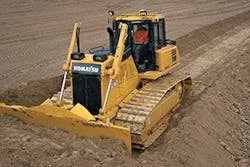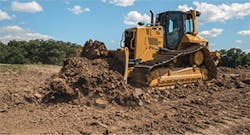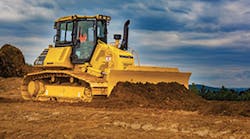Alongtime bulldozer operator knows their machine. Getting the right grade takes precision, and a great operator can get the right angle without always seeing over the blade. It’s all about feel.
When a trained operator is at the helm, they don’t hesitate. They don’t second-guess. They know how their machine is supposed to feel and sound, and how to get it to cut a specific grade without error. It isn’t easy. And that expertise only comes with experience—many, many years of experience. Great dozer operators can spend years to decades honing their skills.
Good dozer operators typically have a great attitude about their work, and they want to learn whatever skills are necessary to do their job to the best of their ability, says Bob Powers, Caterpillar senior product consultant. The job requires specific skills to be able to operate a machine when you can’t see over the blade.
“There is a great deal of ‘feel’ and finesse involved in being a really good operator. A person needs to be exposed to a wide variety of applications and ground conditions to develop that,” he says. “A good operator has to take pride in their work and have a keen interest in improving their skills. If they do, they are likely to come along much more quickly.”
But with construction companies facing a deficit of new operators amidst a flood of retiring dozer operators, they’ve leveraged technology to get operators up to speed quicker. According to the US Bureau of Labor Statistics, construction jobs are expected to grow 10% from 2014 to 2024, up from a current labor market of 424,000.
While the economic outlook of construction equipment operators in general is optimistic, the difficulty of running a dozer means an influx of new employees won’t be helpful for dozer operations if they’ve never set foot on a job site before. “Workforce availability for finding operators is getting tougher every year,” says Mark Oliver, John Deere product marketing manager for dozers. “You can’t just pick a guy off the street and throw him in a dozer. It’s not an easy thing to understand.”
In general, it’s estimated that 10,000 Baby Boomers will retire each day until 2030, according to a statistic cited by the Social Security Administration’s 2012 annual fiscal report. That march out of the workforce has affected nearly every industry, but experts say this hits the construction industry particularly hard due to a loss in institutional knowledge. Overcoming this loss of experienced operators means providing new and mid-level operators with more tools to use these complicated pieces of equipment more efficiently. Everything from three-dimensional (3D) GPS coordination, to automatic anti-teetering technology are used to help dozer operators use their equipment more efficiently, despite the learning curve.
All of this translates to meaningful cost savings for construction workers, because less time has to be spent training new operators. A job can be completed faster, because grades are easier to achieve and fewer grades are cut under or over their specifications, leading to a more cost-efficient job. This can be especially helpful since smoother, more accurate grades avoid the hassle of the backfilling necessary when an operator cuts a grade too deep. And, fewer mistakes mean fewer people need to be hired to inspect grades onsite.
“I think, in the future, we’ll have more and more customers finishing jobs faster—finishing jobs at lower cost, and finishing jobs more accurately through the use of GPS or machine control,” says Kurt Moncini, Senior Product Manager at Komatsu.
Assistive technology is broken up into two camps: Guidance software and hardware enhancements. The guidance software includes items like 3D GPS displays. The hardware enhancements are alterations made to the dozer itself, like blade response settings and various joystick controls.
John Bauer, brand marketing manager for CASE Construction Equipment, says dozers require a mix of precision control and brute force. Assistive technology began entering the workforce as a way to lessen the grade on that learning curve.
“Today’s dozer technology, however, has significantly improved how operators interact with these machines, and how quickly they can get up to speed on operation,” he says. “In the CASE product lineup, this includes control customizations that allow the operator to better tailor machine performance to job-site conditions, including the ability to set blade sensitivity, steering sensitivity, and shuttle sensitivity to smooth, moderate, or aggressive.”
Operators have mountains of data at their fingertips. Dozers can be equipped with 3D grade control with GPS, electrohydraulic controls, and grade load optimization technology. The GPS controls particularly help operators manage their job site. 3D GPS helps operators see the area in front of them, even if the blade is blocking their view. Screens in front of the operator show the 3D area in front of them, as well as what angle the operator needs to set the blade to achieve the proper grade.
The screens show the site in width, length, and depth, and it helps the operator in a few ways. First, they can physically see the job site beyond the blade. Second, they can use the dozer’s on-board computer to see what angle they need to set the blade to achieve the correct angle.
“This empowers operators of all experience levels to operate efficiently,” says Sebastian Witkowski, Komatsu product manager. “It allows operators to know real time and real position and they utilize that info to get a straight grid—no over or undercutting.”
Bauer says two-dimensional (2D) solutions are also an option to help improve functions, like automatic tilt or automatic height functions. But the more advanced options, like 3D design information, help operators master grades and contours with more efficiency than by feel alone.
“This all ultimately serves the purpose of allowing dozer operators to complete their work faster and with greater accuracy, which in turn reduces the total operating costs of that job site in terms of labor, fuel, and wear and tear on the machine,” he says. “Essentially accomplishing the same work for much less.”
A Caterpillar D6N piles up the dirt.
Powers says that dozer technology has improved over the past few years to improve nearly every part of the dozer operation process. “On the machine side, features like Auto Shift take over some tasks from the operator so the dozer can run in its most efficient mode without constant adjustment,” he says. “Blade response can also be set in many tractors, allowing a newer operator to slow the blade response as they develop feel.”
There’s also technology such as the inertial measurement unit that uses a gyroscope and accelerometer to help small- and medium-sized dozers to stabilize the blade during operations, he says. This helps new operators avoid the “teetering sensation” they sometimes experience.
New operators often don’t have a “feel” for how much material is on their blade, so technologies like this helps them develop that sense quicker—and helps them work without that skill set. “It can be a challenge to get a feel for how much to load the blade before you lose productivity through track slip,” says Powers. “This is even more the case with today’s quieter engines because you can’t ‘hear’ when it’s about to happen. The operator has to learn to feel and visually monitor track speed.”
Automations such as this helps even trained operators get their jobs done faster. Even with years of training, it can help to have a tool that increases efficiency and minimizes error, he says.
“Even experienced operators benefit from ‘Slope Assist’ as they are able to achieve satisfactory surface finishes quicker, and with fewer blade commands, than they could do so manually,” says Powers. “Inertial Measurement Units [IMUs] are also becoming utilized to control track slip due to its accelerometer feature. By measuring the dozer’s ground speed with the accelerometer and comparing it to the dozer’s measured track speed, track slip can be determined and blade corrections automatically commanded to prevent track slip, thus leaving a better finished surface.”
But machine assistive technology doesn’t stop there, Powers states. Automated functions in dozers now touch upon nearly every aspect of operating this piece of equipment, and they’re also used in a host of construction equipment machines. “Dozer manufacturers have also made design changes to accommodate the wide range of operator experience/backgrounds, with things like improvements in visibility and joystick style controls,” he explains. “Features like Auto Carry and Dual Tilt help set blade position for optimal dozing.”
Oliver says these advancements are even being embraced by highly experienced operators, because they can improve the quality of an entire crew. Construction managers will often request these enhancements on new models, and more companies are offering these services than ever before.
Komatsu’s D61PXi
“We completely recognize the need for technical integration to make operator life easier,” says Oliver. “We want to make sure we’re delivering what they want.”
Technological advancements also extend to operator controls—and even physical comfort. Operators can set their chair position, the blade speed and other settings on a “speed dial,” which can be used to automatically reset everything inside the dozer when another operator takes the helm.
“When it comes to the base machine, what we’re finding is electronics allow an opportunity for an operator to tune the machine to his preferences,” says Moncini.
Training operations have also highly benefited from the inclusion of virtual reality and immersive technology options. While virtual reality seems like it’s only used in futuristic video games and Silicon Valley operators, they’re highly effective training tools for construction equipment operators, Oliver says. Imagine being able to practice grades without the fear of completely tearing up a job site or damaging an expensive dozer, he adds.
Oliver says virtual reality is used to help brand new operators get a feel for a bulldozer. An operator can hop into a fake bulldozer that has screens set up to emulate a job site, and they run through the simulated challenges.
“Simulators are a great first step,” he says. “There’s no fuel being burned; there’s no risk of damage. As operators are becoming harder and harder to come by it’s an easier way to get a newer operator up to speed.”
Moncini says Komatsu uses virtual reality for excavators and hopes to extend the program to dozers. It’s an invaluable tool for training operators on difficult and expensive machines such as dozers or other construction equipment. “It is so realistic, you almost get motion sick,” he says.
The virtual reality setups have mostly used quasi-immersive experiences. But some companies expect full headsets to make their way into the training environment eventually, which would allow an operator to be immersed in a simulated job site.
With the right visual cues and the proper faux dozer simulator, a virtual reality environmental could make an operator feel the resistance when a blade cuts into a grade, feel what it’s like when a blade starts to tilt, and hear the roar of the busy job site around them.
Some companies also offer training videos on YouTube, or send in-person trainers for traditional training sessions. Libraries of videos help operators get up to speed faster, whether they’re on the go or at home, and this helps longtime operators keep up-to-date on the latest technologies.
As for the future, bulldozer manufacturers are focused on matching technological advancements with their customers’ needs. Some experts believe more models of dozers will start to incorporate 3D GPS technology—since some sold models don’t come with that technology already installed—but others noted it’s important to provide dozer models at various price points to meet various needs.
After all, smaller job sites may not need 3D technology and could consider this expensive, Bauer says. But other managers will see it as a necessity.
Sometimes that means scaling these 3D GPS technologies up and increasing virtual reality accessibility, and sometimes that means meeting customers’ budget requirements and installing the most practical device at an affordable price point. “Our focus moving forward continues to be scalability. Not every owner or operator needs that high-end 3D system,” says Bauer. “We work to fit each operator with the system that’s right for them.”










